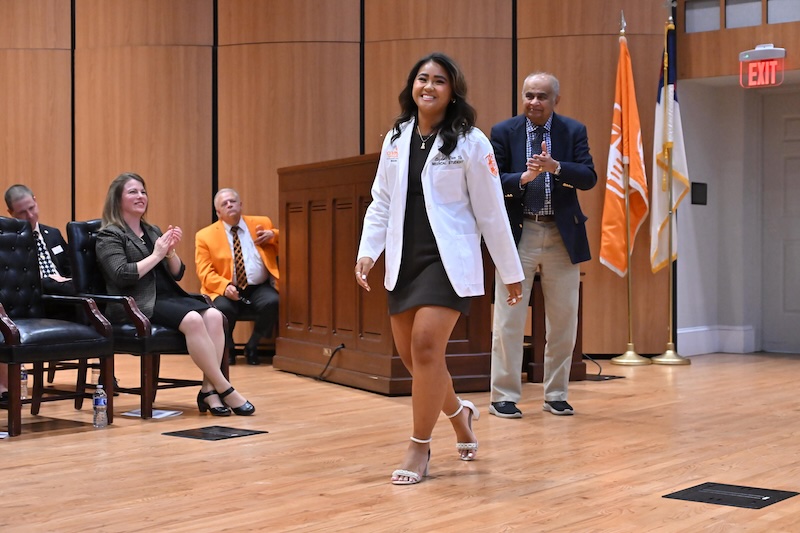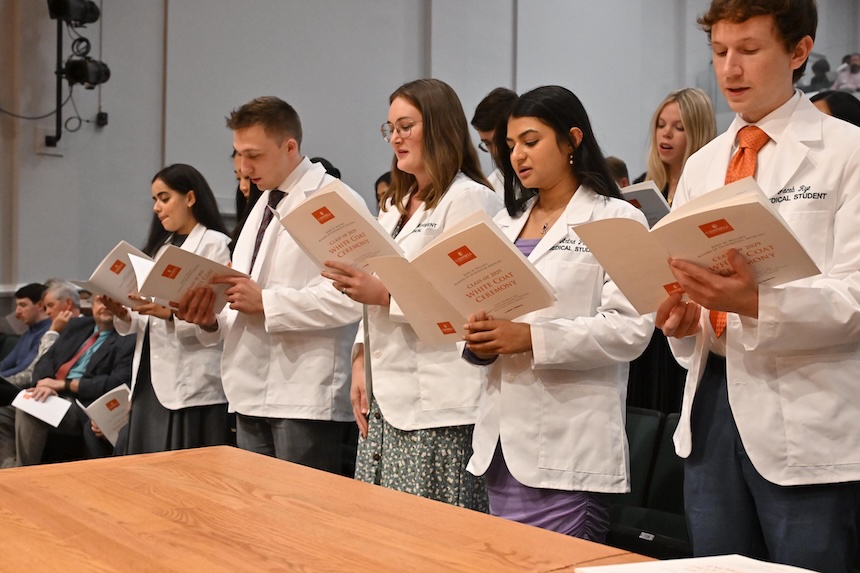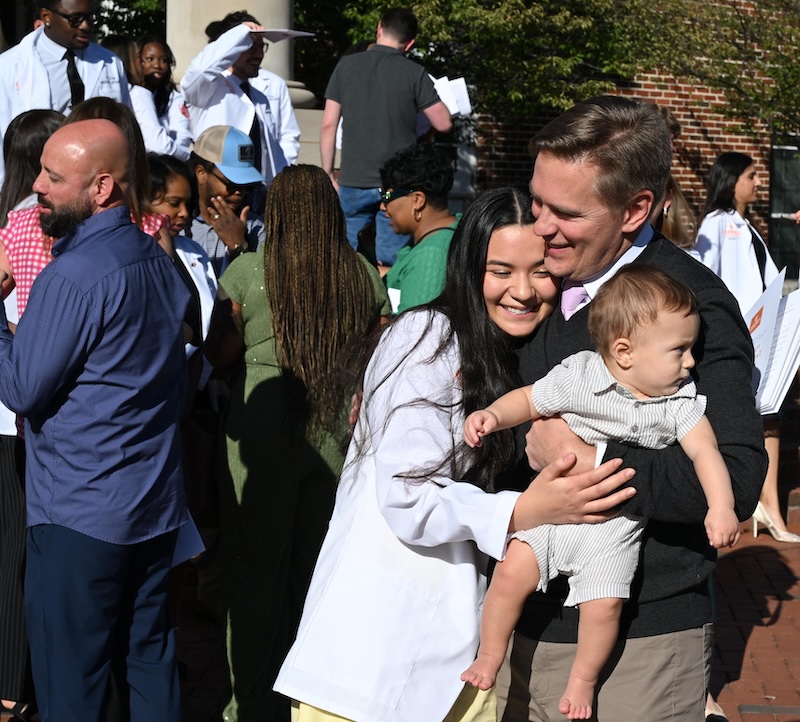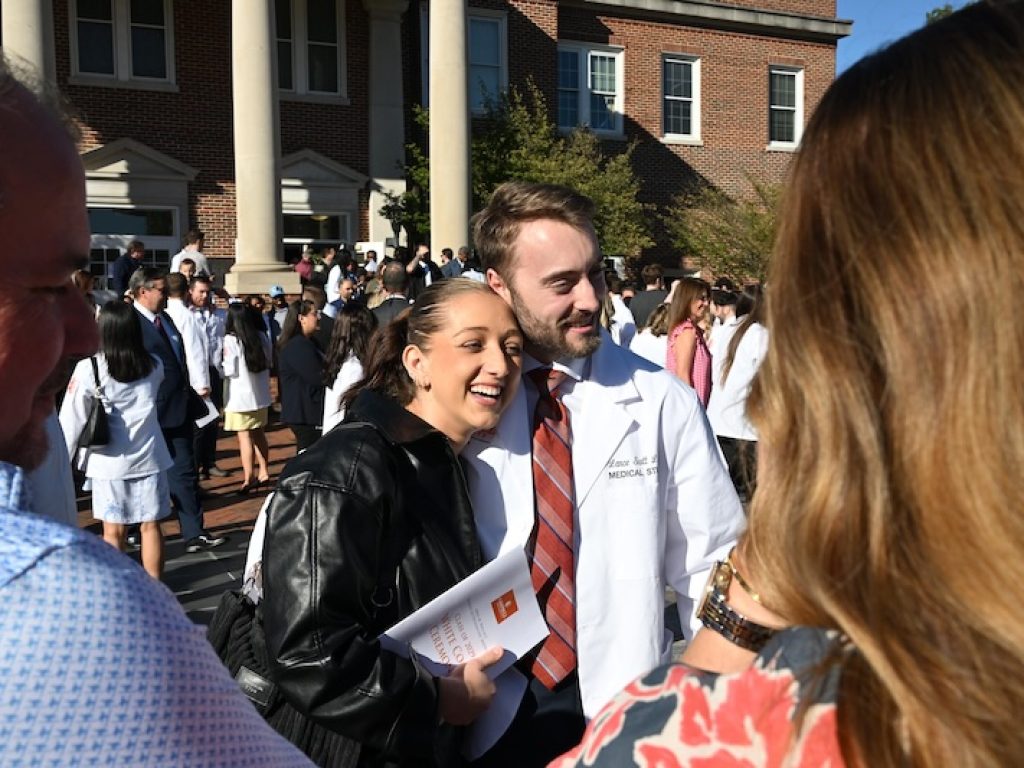Dr. Melissa Davies looked out at the medical students, all seated together and listening intently. All holding new, bright white coats.
The Campbell University Class of 2029 White Coat Ceremony, as Davies said, marks a rite of passage for first-year med students. The class, composed of 162 students, officially donned their coats toward the end of the ceremony, held Oct. 17 in Hobson Performance Center.
The students’ journey has really just begun. Yet, Davies told the students, they’ve already traveled quite a distance.
“You have successfully completed Block One of medical school,” she told them. “Take a moment to let that settle in.”
You have started, she said, building the critical scaffolding of your clinical skills.
“This moment is more than a landmark. It is the rite of passage, a ritual of initiation into a profession that demands more than just knowledge,” she said. “It demands resilience, humility, empathy and a lifelong commitment to growth.
“You’ve made it to a remarkable milestone in your journey, a journey that is as personal as it is professional, as intellectual as it is deeply human,” Davies told the students.
Davies, who grew up in Fayetteville, graduated from Campbell with a bachelor’s degree in 2010 and was a member of the first graduating class of the Jerry M. Wallace School of Osteopathic Medicine (CUSOM) in 2017.
Not only was Davies a member of that first class, said interim medical school Dean Dr. David L. Tolentino, but she also has the distinguished honor of being the first student ever accepted to the School of Osteopathic Medicine. Davies was certified by the American Board of Obstetrics and Gynecology in 2022 and in July of this year joined Novant Health WomanCare in Kernersville, where she continues her commitment to serve patients in a small and rural community hospital.

The white coat worn by physicians and medical professionals is a symbol of friendliness, purity and righteousness. Its symbolic origins date to the advent of aseptic surgery, in the late 1800s. The white coat ceremony is held at more than 100 medical schools across the country.
“The white coat you are soon to wear is more than just a piece of clothing,” Davies said. “It is one of the most recognizable and enduring symbols of the medical profession, worn by physicians for more than a century.”
Before that, Davies said, doctors traditionally wore black coats. Not because they were trying to be intimidating but because medicine was often associated with mourning, uncertainty and a less hopeful prognosis.
As part of the ceremony, Dr. Jerry Wallace recognized Dr. Ronald Maddox as a CUSOM Founders Recognition Recipient. Wallace is a past Campbell president, and the medical school bears his name.
Maddox came to Campbell in 1985 and established the School of Pharmacy, renamed in 2009 the College of Pharmacy & Health Sciences. As founding dean, Maddox developed an academic program offering the first Doctor of Pharmacy program in North Carolina, according to his bio. The school thrived, and in October 2010 Maddox was named vice president for health programs and continued to serve as CPHS dean until his retirement in 2014. Under his leadership, his bio says, graduating pharmacy classes maintained a 98.5 percent passage rate on the North American Pharmacy Licensure Exam, well above national and state averages.
Maddox earned a doctor of pharmacy degree from the University of Tennessee and became an assistant professor of pharmacy practice at Mercer University School of Pharmacy, in Atlanta, where he became a professor and executive associate dean. Twice he was recognized as “Professor of the Year.”
The Founders Day award is presented each year to recognize and show continuing gratitude to recipients who have continued to provide outstanding support for the medical school, says a proclamation, read by Tolentino.
“Our founders have invested in the future of healthcare, enabling us to educate, inspire and empower future physicians committed to serving humanity with the highest ethical standards,” Tolentino said. “Their unwavering dedication and belief in this mission have built a legacy that will impact generations, shaping the physicians of tomorrow and the communities they will serve.”

Others who spoke during the ceremony included Campbell University President Dr. William M. Downs, Student Government Association President John DiCristo and Dr. Heather Weber, director of Clinical Education at the med school.
Weber talked about the history of the white coat, its evolution and meaning of the clinicians’ uniform.
“White coats have been the most prominent symbol of the physician since the development of aseptic surgery in the United States, in about 1889,” Weber said.
As the medical profession began associating itself with science, which was earning the public’s interest and trust, by 1920 the white coat had become a powerful and iconic symbol of the physician as a medical scientist, Weber said.
The white coat ceremony holds profound significance, Tolentino said.
“It is time for us to formally recognize the dedication and perseverance that has brought you to this point,” he said. “The white coat you will don today symbolizes the responsibilities you will assume as future physicians and the trust that society places in you as healers. It’s a symbol of compassion, integrity and the pursuit of knowledge.”
The white coat isn’t about prestige, Davies said.
“It is about responsibility,” she said. “It represents professionalism, caring and trust, values that must be earned and not assumed. It is not a cloak of invincibility. It is a symbolic promise that you will strive to be competent in knowledge, compassionate in spirit and humanistic in practice. That you will listen, actively communicate clearly and treat each patient as a whole person; not just a diagnosis, not just a chart. Not just a case.”


